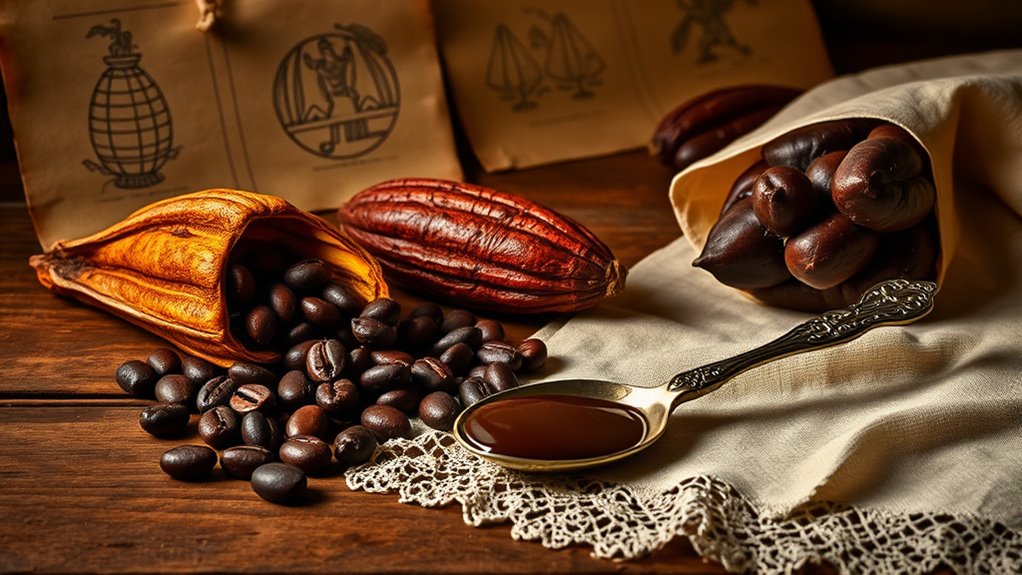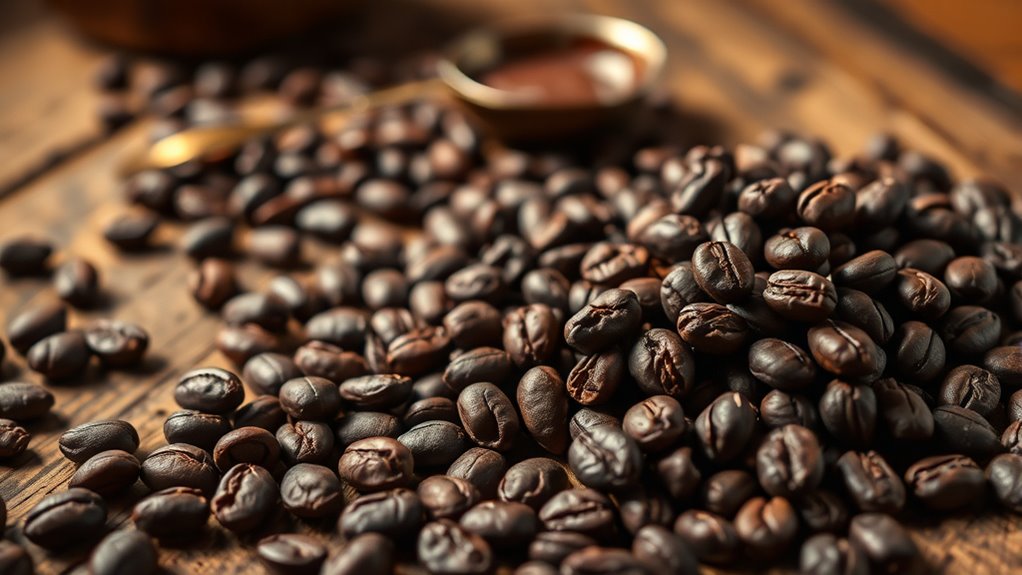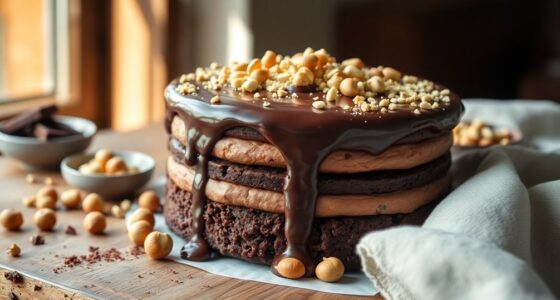Chocolate’s history spans over 3,500 years, originating with ancient civilizations like the Olmecs, Mayans, and Aztecs, who used cacao in sacred rituals and as currency. When Europeans encountered cacao, they transformed it into a sweet beverage enjoyed by aristocrats. Later, innovations like the chocolate press made solid chocolate possible, fueling its mass production and global popularity today. If you explore further, you’ll uncover the fascinating journey from sacred ritual to everyday indulgence across cultures and centuries.
Key Takeaways
- Cacao has been cultivated for over 3,500 years by ancient civilizations like the Olmec, Mayans, and Aztecs, who used it ceremonially and as currency.
- Europeans introduced cacao to Europe in the 16th century, where it became a luxury, initially consumed as a bitter beverage.
- The development of processing techniques, including the chocolate press in 1828, transformed cacao into solid chocolate bars and candies.
- The Industrial Revolution enabled mass production, making chocolate more accessible and popular worldwide through major brands.
- Today, chocolate encompasses diverse varieties and continues evolving with innovations, cultural significance, and ethical sourcing practices.

Have you ever wondered how chocolate became the beloved treat it’s today? It all started thousands of years ago in the ancient civilizations of Central and South America. The earliest known use of cacao dates back to around 1500 BCE, where the Olmec people cultivated and used cacao beans, although their exact purpose remains a mystery.
Chocolate’s journey began over 3,500 years ago with ancient Central and South American civilizations.
Later, the Mayans and Aztecs recognized cacao’s value, transforming it into a drink called “xocolatl.” This bitter, frothy beverage was reserved for nobility, priests, and royalty, and it held religious and ceremonial significance. They believed cacao had divine properties, and it was often used as currency, highlighting its immense worth in their societies.
When the Spanish explorers arrived in the 16th century, they encountered this exotic drink and brought it back to Europe. Initially, Europeans viewed cacao as a luxury item, and it remained a delicacy reserved for the wealthy. They sweetened the bitter liquid with sugar, honey, or vanilla, creating a more palatable version that quickly gained popularity among aristocrats.
Over time, the recipe evolved, and chocolate shifted from a beverage into solid forms. The development of new processing techniques, like the invention of the chocolate press in 1828 by Coenraad Van Houten, allowed manufacturers to produce powdered cacao and cocoa butter more efficiently. This breakthrough led to the creation of solid chocolate bars and candies, making chocolate more accessible to the general public.
The Industrial Revolution played an essential role in shaping modern chocolate as we know it. Mass production and innovations in machinery lowered costs, enabling companies to produce large quantities of chocolate at a faster rate. Brands like Cadbury, Hershey, and Nestlé emerged during this period, establishing themselves as household names.
They refined the taste, texture, and packaging, turning chocolate into an everyday indulgence. Today, you can find countless varieties—from dark, milk, to white chocolate—each with unique flavors and textures. The global chocolate industry continues to grow, driven by innovations, ethical sourcing, and a passionate consumer base.
From its sacred origins to its status as a global commodity, chocolate’s journey is fascinating. It reflects cultural shifts, technological advances, and the universal appeal of something sweet and satisfying. The next time you enjoy a piece of chocolate, remember the rich history behind it—a story that spans centuries and civilizations, all rooted in the simple pleasure of a cocoa bean. Additionally, modern marketing strategies, such as data-driven marketing, have helped maintain chocolate’s popularity worldwide.
Frequently Asked Questions
How Is Chocolate Made From Bean to Bar?
You start by harvesting ripe cacao pods and removing the beans. Then, you ferment and dry the beans to develop flavor.
Next, you roast the beans to bring out aroma, and crack them open to remove shells. You grind the nibs into a paste called chocolate liquor, which you mix with sugar, cocoa butter, and sometimes milk.
Finally, you temper the mixture, pour it into molds, and let it cool into bars.
What Are the Health Benefits of Dark Chocolate?
Ever wonder why dark chocolate is praised for health? You get antioxidants that fight free radicals, helping your body stay balanced.
It can improve your heart health by lowering blood pressure and boosting circulation. Plus, it may enhance your mood by releasing endorphins.
Don’t you want a treat that satisfies your cravings while giving you benefits? Enjoy dark chocolate in moderation for a delicious boost to your well-being.
Which Countries Produce the Most Cacao Beans?
You might wonder which countries lead in cacao bean production. Ivory Coast and Ghana top the list, supplying most of the world’s cacao.
Indonesia, Nigeria, and Ecuador also produce significant amounts. These countries have ideal climates for cacao cultivation, with warm temperatures and rainy seasons.
If you’re interested in chocolate, knowing where the beans come from helps you appreciate the diverse origins and flavors that influence your favorite treats.
How Has Chocolate Influenced Global Trade Historically?
You see, chocolate has markedly shaped global trade by creating a demand that led to the expansion of cacao cultivation and trade routes. Countries like Ghana, Ivory Coast, and Indonesia became key exporters, fueling economic growth and colonial exploration.
This trade influenced political relationships and introduced new markets worldwide. As a result, chocolate’s popularity helped establish an interconnected, global economy, shaping international commerce that persists today.
What Are the Best Ways to Store Chocolate?
Think of your chocolate as a delicate treasure that needs safeguarding. To keep it fresh and melt-in-your-mouth perfect, store it in a cool, dry place away from sunlight, ideally between 60-70°F.
Wrap it tightly in foil or an airtight container to prevent odors from seeping in. Avoid refrigerating, as humidity can cause bloom.
With care, your chocolate stays a joyful delight, ready to melt hearts anytime.
Conclusion
As you savor that next bite of chocolate, remember you’re tasting centuries of history, a rich tapestry woven with ancient civilizations and daring explorers. Chocolate’s journey is like a river flowing through time, carrying stories of discovery, culture, and passion. So, the next time you indulge, know you’re part of a sweet legacy that’s as timeless as the stars, making every moment with chocolate a delicious chapter in your own story.









